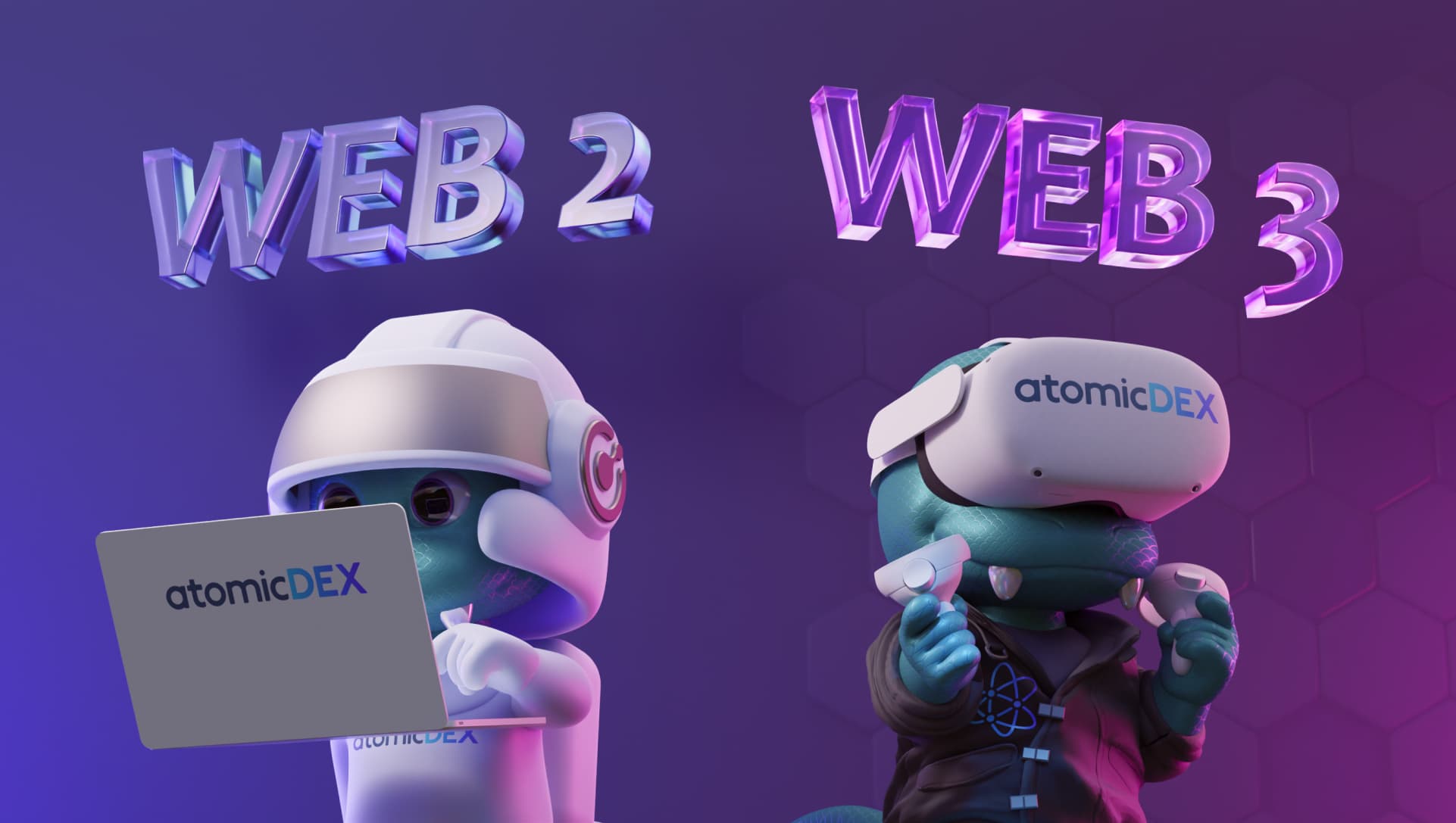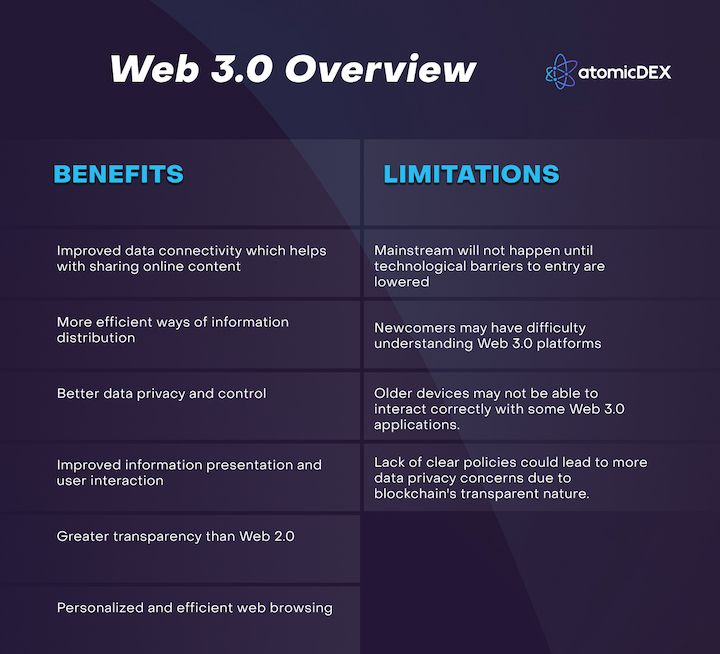17 January 2023
Updated: 17 January 2023
Web 2.0 vs. Web 3.0 The Growth of Online Interactions

Web2 vs Web3
Table of contents
The key difference between web 2.0 and web 3.0 is data ownership. Web 3.0 gives internet users complete control over all their online data with improved security.
Web technology has evolved since the invention of the internet, and is now very different from the static text-based version used years ago.
The need for more secure and interactive ways to communicate and exchange value online informed new technology focusing on improving security, utility, and the overall experience on the internet. This need also led to a continuous evolution of web communication, now categorized into three phases: Web 1.0, Web 2.0, and Web 3.0.
A Quick Overview of the Web Evolution
Understanding the evolution of the internet requires a brief history of the three phases of web communication:
Web 1.0
While working at CERN (European Organization for Nuclear Research) in the early 90s, computer scientist Tim Berners-Lee created the first version of the internet, or Web 1.0, also known as the Classic Web. The main aim was to create a more efficient way to share information. During this phase, the internet focused primarily on sharing messages through HTML documents via web browsers. To accomplish this, Berners-Lee designed a way to connect computers so that all users on the network could easily share information through web pages.
Although Web 1.0 successfully created a better way to share information, only a few large organizations, government bodies, and military outfits used it. Due to its complexity, individuals and smaller organizations could not benefit from Web 1.0 technology. This brought about the next phase, which promoted improved interactivity and usability to make the web more accessible.
Web 2.0
The second phase of internet communication transitioned the web from basic, static web pages to more dynamic pages with user-generated content. Web 2.0 has revolutionized the web and how people share information over the internet. It also simplified the process of creating and distributing content on global networks. Social media applications such as Instagram, Facebook, and Youtube are examples of Web 2.0 platforms.
Web 3.0
This generation of web communication is known as the 'Semantic Web.' Web 3.0 facilitates "read-write-execute" functionality in information sharing. It focuses on structuring and linking data to enable more effective discovery, automation, integration, and reuse across multiple applications.
Web 3.0 is the phase of the internet based on blockchain technology, which incorporates concepts such as decentralization and token-based economics, including crypto assets and NFTs. Additionally, Web 3.0 helps creators own their work on the internet without the control, censorship, and monetization rules typical of big centralized institutions.
What is Web 3.0?
Web 3.0 is the decentralized version of internet communication. It aims to establish trust on the internet without the interference of any centralized institution like the government or large companies, while also establishing genuine digital ownership. Web 3.0 furthers Web 2.0's functionality by allowing computers to execute programs autonomously. By using smart contracts, computers can receive, analyze and execute an agreement between different parties on a network.
Web 3.0 leverages peer-to-peer technologies like blockchain and virtual reality (VR) to significantly reduce centralized data control and improve decentralization. With improved decentralization, users can control their online content and fully own their data.
What Is the Difference Between Web 2.0 and Web 3.0?
Some of the most notable areas where the second and third generations of the web differ include the following:
Privacy
The most notable upgrade from Web 2.0 to Web 3.0 is the removal of centralized third parties needed to facilitate interactions between users. Internet users directly interact with each other via peer-to-peer services instead of relying on companies to facilitate the exchange. This way, users do not have to worry about an intermediary gaining access to their private information or assets.
Enhanced connectivity
Web 3.0 also improves on the connectivity of its predecessor. The use of semantic data in blockchain-based web interactions gives way to new forms of organizing, using, and discovering information. This sets a path for Web 3.0-based innovations with improved user experiences and more diverse functionality.
Decentralization
Unlike Web 2.0, the decentralized networks of Web 3.0 ensure that users have complete control over their online data. This decentralized web significantly improves privacy and security because everything runs on distributed ledger technology, making network data impossible to alter from any single point of failure.
Additionally, decentralization makes crypto payments accessible to anyone around the world. This improves cross-border transactions and eliminates the need for expensive middlemen in traditional Web 2.0 financial infrastructures.
Trustless and Permissionless
Web 3.0 does not require users to disclose personal information to access any service, reducing the likelihood of compromising privacy or sensitive information. Furthermore, using smart contracts in Web 3.0 means that individuals do not need to interact with third-party actors. This method creates a permissionless system where trades are executed automatically based on prewritten conditions encrypted into smart contracts.
Benefits and Limitations of Web 3.0 Over Web 2.0
Some of the benefits and limitations of Web 3.0 over Web 2.0 include the following:

Common Misconceptions About Web 3.0
Like any new technology, there are still general misconceptions surrounding Web 3.0, its functionality, and its design. Some of these include:
Web 3.0 Isn't the Same Thing as the Metaverse: Although they are related, Web 3.0 and the metaverse are not exactly the same. Web 3.0 is an all-encompassing new internet version comprising new technologies, apps, and capabilities. On the other hand, the metaverse is only a small part of Web 3.0.
Web 3.0 Is 100% Decentralized: The idea behind Web 3.0 is to enable decentralized interaction and data sharing online. However, many Web 3.0 platforms still have aspects of centralized ownership and control. Web 3.0 is still a long way from total decentralization and global accessibility.
The Web 3.0 Future
The evolution of the web is not about eliminating the previous versions but addressing their problems and limitations. Web 2.0 made Web 1.0 more interactive, and Web 3.0 aims to make Web 2.0 more user-centric by enabling the decentralized exchange of value on the internet. However, although Web 3.0 still has a long way to mainstream adoption, it promises significant growth across all sectors. This growth includes token-based economies, decentralized crypto exchanges (DEX), and various novel decentralized blockchain protocols and applications.
Hold and Trade Crypto On AtomicDEX
AtomicDEX is now available as a web application on any device, browser, or OS! Store BTC, ETH, BNB, DOGE, MATIC, and many other cryptocurrencies in your own crypto wallet.
When you're ready to trade, AtomicDEX supports cross-chain swaps.
Create your wallet and start using AtomicDEX Web today.




